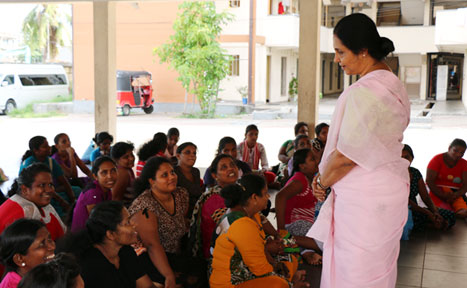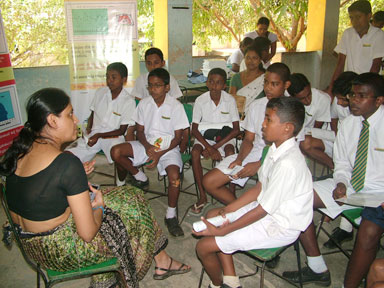|
At least 2 million Lankans over 20 years are
pre-diabetics, many unaware they have the disease:
Fight NCD with lifestyle changes
By Carol Aloysius
Non Communicable Diseases (NCDs) are on a high roller affecting
millions of people mostly in their fifties in every part of the world
including Sri Lanka. Diabetes which occupies the second highest slot in
the long line of NCDs at ten percent, is estimated to afflict at least
two million persons (men and women) in Sri Lanka over 20 years of age.
Long considered the ‘Mother of all diseases’, diabetes, if not detected
and treated in time, can lead to many other serious illnesses such as
Ischaemic heart disease and hypertension as well as stroke and kidney
failure which eventually cause the body system to be severely
compromised and could end with premature death.
|

Focus on a healthy diet |
The most disturbing aspect of this disease is that these conditions
are often without any symptoms and consequently, thousands of persons
are walking around without knowing they even have the disease. Studies
indicate that one third of pre-diabetics are unaware of their risk
status and health officials have warned the numbers could surge to as
high as 25% in the near future due to our aging population.
The Health Ministry has for years battled against this debilitating
disease but wide prevalence indicates that something is amiss and that
the previous focus on the curative aspect needs to be shifted to
preventing it. The Health Ministry’s goal is for Sri Lanka to be NCD
free by 2030. Considering the present obstacles facing health officials,
the big question is, will this goal be achievable?
The Sunday Observer talked to two experts from NIROGI Lanka Project
which together with the approval of the Ministry of Health are trying
out a new approach to fighting diabetes-with lifestyle changes involving
community participation.
Excerpts from interviews with Professor of Surgery, Faculty of
Medicine, University of Colombo Dr Chandrika Wijeyaratne and Senior
Lecturer and public health expert in NCD, Department of Community
Medicine Dr A Carukshi Arambepola …
Q:In the past decade Non Communicable Diseases ( NCDs like
diabetes, cardiac, hypertension, kidney failure and cancer, have soared
in Sri Lanka. Although we have official data, it is said the unofficial
rates are very much higher. What in your opinion is the estimated number
of persons with NCDs in Sri Lanka? What is the difference between ten
years ago and now?
A. With respect to diabetes the number of adults over the age
of 20 years afflicted is around 10% of our population – therefore
estimated as at least 2 million persons (both men and women).
No doubt this proportion will rise with increasing age in that about
25% of people have diabetes or pre-diabetes. These conditions are often
without any symptoms. The local data suggests that approximately one
third of them are unaware of their risk status.
With reference to high blood pressure this is even greater in that
almost 40% of our adult population is affected.
Currently Ischemic heart disease is the leading cause of mortality in
hospitals in Sri Lanka. Hospital admissions due to diabetes and related
complications have shown a rise from 86 to 226 per 100,000 over the past
two decades.
Q: For example?
A. For example, when a small proportion of people with end
stage kidney disease twenty years ago had diabetes, in the current day
this figure is closer to about ¾ths. Chronic NCDs accounted for 71% of
all deaths in Sri Lanka, compared with 18% due to injuries, and 11% due
to communicable diseases, and maternal and prenatal conditions.
Moreover, trend analysis suggests that NCD mortality rates have been
rapidly increasing during the past decade (Register General, 2008).
Q:What are the main causes for this steep rise of NCDs despite
interventions by the Health Ministry and various NGOs?
A. The root causes are unhealthy lifestyle i.e. food and drink
rich in starch, salt, sugar and fats with low consumption of vegetables
and fruit coupled with insufficient physical activity that encourage
obesity. In parallel, tobacco and alcohol consumption makes these
vulnerable persons at greater risks of cardiovascular disease, chronic
lung disease, diabetes, and cancer – the commonest chronic NCDs.
Q: As you have pointed out many of these NCDs are preventable.
Yet they continue to persist. Why? Are they all life style related?
A. There are few risk factors shared among all major chronic
NCDs. Those are unhealthy diet, lack of physical activity, tobacco and
alcohol consumption.
All of them are life style related. Main causes for the current NCD
epidemic is due to changing lifestyles, consuming more fast food and
unhealthy diets, tendency for consumption of more alcohol and tobacco,
living in polluted environments etc.
According to recent research about 80% of adults do not consume
adequate amount of fruits and vegetables. Saturated fat consumption,
which is an important risk factor for cardiovascular disease is also
high. Dietary intake of salt (10g/day) and sugar (60g/day) is also high
in Sri Lankan diet when compared to WHO recommendation.
Prevalence of current smokers and alcohol consumers among adult male
are 22.8% and 26% respectively.
Q: What about physical exercises?
A. Only a small proportion is engaged in regular physical
exercises, which is also a very important factor in reducing NCD risk
factors.
Q: I understand Nirogi Lanka project of the SLMA is currently
promoting a new approach with the help of the Health Ministry, to tackle
this problem using community involvement as a base, to change
lifestyles. How can life style changes help control NCDs? Can they also
prevent them?
A. Prevention is better than cure. Prevention works at all
three following levels;
a) Primary prevention is focused on activities we do to prevent the
onset of NCDs. This is mainly by addressing the four risk factors that
cause NCDs.
b) Secondary prevention is carried out mainly for people who have
already got NCDs, in order to prevent /delay any multi-organ
complications of the disease (sometimes fatal and serious) that may
affect the quality of life and life span.
c) Tertiary prevention is carried out among those who have already
developed the complications of NCD to enable patients to lead a near
normal life, which includes rehabilitation and disability limitation.
Q: Which of them is most effective?
A: Of the three prevention types, the most cost effective is
primary prevention as people are not yet ill and the main strategy used
is by promoting a healthy lifestyle. By addressing the lifestyle, we can
keep the four risk actors of NCDs under control (healthy diet, physical
activity, no smoking, no alcohol). Strategies used for this purpose are
simple, low cost, rewarding and enjoyable. It can change individuals and
thereby change their families and finally communities or workforces.
However, changing lifestyle is not an easy task, it could be done by
educating people on healthy lifestyles and by empowering them to take
control of their lives to bring out a change in their lives.
Of the two, the more sustainable approach is by empowering people to
take correct decisions on their own lifestyle. Here, we mainly focus on
addressing the factors that underlying the risk factors, and changing
for the better through continuous measurement and reflective practice.
One important message is to come up with culturally appropriate and
practical solutions so that they are all doable. Primordial prevention
is another aspect to primary prevention that includes activities that
stops risk factors before they establish in an environment. A good
example would be prevention of gestational diabetes in mother so that
the risk of her offspring getting diabetes in future is minimal.
Q: Dr Wijeyaratne, you have worked in hospitals abroad and
been exposed to various innovative approaches to general health
including NCD. Tell us about some of those experiences and how far they
can be used in Sri Lanka.
A. Patient self management through education by teams of
doctors, nurses, midwives and counselors, where the emphasis is on
patients being in charge of and accountable for their own health and
well being
Q: What are the implications of rising NCDs on families?
A.The government of Sri Lanka has identified that the
prevention and control of chronic NCDs as a priority issue in the
national health agenda and the National Health Master Plan 2007-2016 as
these diseases lower the quality of life, impair the economic growth of
the country and place a heavy and rising demand on families and national
budgets.
Currently treatment of NCDs accounts for nearly 90% of the total
disease burden..
Q: Gaps?
A. There is a gap in service provision of public health
facilities due to continuous resource gap, frequent unavailability of
essential drugs and other diagnostic testing.
Out of pocket expenditure will create an extra burden on the patients
particularly on poor.
Premature death and disability from these conditions (< age of 65
years) translates to poor work performance and productivity.
Individual patients and their families face catastrophic expenditure
with sudden life threatening events that require coronary stents and
surgery, stroke disability and rehabilitation, kidney dialysis and
transplantation and complex cancer treatments.
Q: Your message to the public?
A. Live your life to the fullest by adopting healthy habits of
home cooked food with adequate vegetables and fruits and by avoiding
sweetened beverage, engage in regular physical activity, stop tobacco
and alcohol and remain mindful at all times.
This will steer you and the generations ahead onto a healthy path.
 |
 |
|
Community based
programs conducted by Dr Carukshi Arambepola and Prof
Chandrika Wijeyaratne |
|

